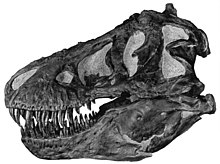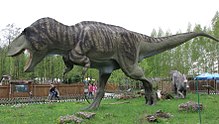Description
Tyrannosaurus rex was one of the largest land carnivores of all time; the largest complete specimen, located at the Field Museum of Natural History under the name FMNH PR2081 and nicknamed Sue, measured 12.3 meters (40 ft) long,[4] and was 4 meters (13 ft) tall at the hips.[5] Mass estimates have varied widely over the years, from more than 7.2 metric tons (7.9 short tons),[11] to less than 4.5 metric tons (5.0 short tons),[12][13][page needed] with most modern estimates ranging between 5.4 metric tons (6.0 short tons) and 6.8 metric tons (7.5 short tons).[6][14][15][16] One study in 2011 found that the maximum weight of Sue, the largest Tyrannosaurus, was between 9.5 and 18.5 metric tons (9.3–18.2 long tons; 10.5–20.4 short tons), though the authors stated that their upper and lower estimates were based on models with wide error bars and that they "consider [them] to be too skinny, too fat, or too disproportionate".[4] Packard et al. (2009) tested dinosaur mass estimation procedures on elephants and concluded that those of dinosaurs are flawed and produce over-estimations; thus, the weight ofTyrannosaurus could have been much less than previously thought.[17] Other estimations have concluded that the largest known Tyrannosaurus specimens had masses approaching[18] or exceeding 9 tonnes.[4][19][20]
The neck of Tyrannosaurus rex formed a natural S-shaped curve like that of other theropods, but was short and muscular to support the massive head. The forelimbs had only two clawed fingers,[21] along with an additional small metacarpal representing the remnant of a third digit.[22] In contrast the hind limbs were among the longest in proportion to body size of any theropod. The tail was heavy and long, sometimes containing over forty vertebrae, in order to balance the massive head and torso. To compensate for the immense bulk of the animal, many bones throughout the skeleton were hollow, reducing its weight without significant loss of strength.[21]
The largest known Tyrannosaurus rex skulls measure up to 1.5 meters (5 ft) in length.[23] Large fenestrae (openings) in the skull reduced weight and provided areas for muscle attachment, as in all carnivorous theropods. But in other respects Tyrannosaurus's skull was significantly different from those of large non-tyrannosauroid theropods. It was extremely wide at the rear but had a narrow snout, allowing unusually good binocular vision.[24][25] The skull bones were massive and the nasals and some other bones were fused, preventing movement between them; but many were pneumatized (contained a "honeycomb" of tiny air spaces) which may have made the bones more flexible as well as lighter. These and other skull-strengthening features are part of the tyrannosaurid trend towards an increasingly powerful bite, which easily surpassed that of all non-tyrannosaurids.[10][9][26] The tip of the upper jaw was U-shaped (most non-tyrannosauroid carnivores had V-shaped upper jaws), which increased the amount of tissue and bone a tyrannosaur could rip out with one bite, although it also increased the stresses on the front teeth.[27][28]
The teeth of Tyrannosaurus rex displayed marked heterodonty (differences in shape).[21][29] The premaxillary teeth at the front of the upper jaw were closely packed, D-shaped in cross-section, had reinforcing ridges on the rear surface, were incisiform (their tips were chisel-like blades) and curved backwards. The D-shaped cross-section, reinforcing ridges and backwards curve reduced the risk that the teeth would snap when Tyrannosaurus bit and pulled. The remaining teeth were robust, like "lethal bananas" rather than daggers, more widely spaced and also had reinforcing ridges.[30] Those in the upper jaw were larger than those in all but the rear of the lower jaw. The largest found so far is estimated to have been 30 centimeters (12 in) long including the root when the animal was alive, making it the largest tooth of any carnivorous dinosaur yet found.[5]
Skin and feathers
Main article: Feathered dinosaur
While there is no direct evidence for Tyrannosaurus rex having had feathers, many scientists now consider it likely that T. rex had feathers on at least parts of its body,[31] due to their presence in related species of similar size. Mark Norell of the American Museum of Natural History summarized the balance of evidence by stating that: "we have as much evidence that T. rex was feathered, at least during some stage of its life, as we do thataustralopithecines like Lucy had hair."[32]
The first evidence for feathers in tyrannosauroids came from the small species Dilong paradoxus, found in the Yixian Formation of China, and reported in the journal Nature in 2004. As with many other theropods discovered in the Yixian, the fossil skeleton was preserved with a coat of filamentous structures which are commonly recognized as the precursors of feathers.[33] Because all known skin impressions from larger tyrannosauroids known at the time showed evidence of scales, the researchers who studied Dilong speculated that feathers may correlate negatively with body size—that juveniles may have been feathered, then shed the feathers and expressed only scales as the animal became larger and no longer needed insulation to stay warm.[33] However, subsequent discoveries showed that even some gigantic tyrannosauroids had feathers covering much of their bodies, casting doubt on the hypothesis that they were a size-related feature.[34]
While skin impressions from a Tyrannosaurus rex specimen nicknamed "Wyrex" (BHI 6230) discovered in Montana in 2002,[35] as well as some other giant tyrannosauroid specimens, show at least small patches of mosaic scales,[36] others, such as Yutyrannus huali (which was up to 9 meters (30 ft) long and weighed about 1,400 kilograms (3,100 lb)), preserve feathers on various sections of the body, strongly suggesting that its whole body was covered in feathers.[34] It is possible that the extent and nature of feather covering in tyrannosauroids may have changed over time in response to body size, a warmer climate, or other factors.[34]
Classification





No comments:
Post a Comment